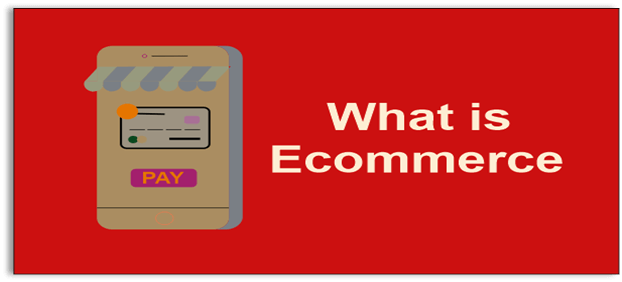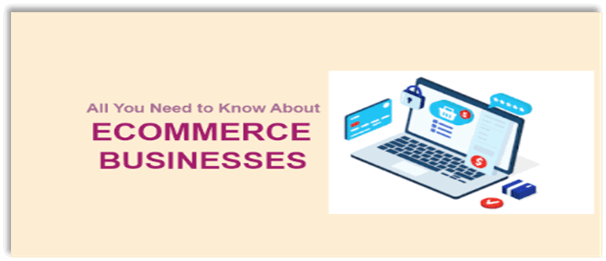Advantages And Disadvantages Of Ecommerce
E-commerce, sometimes referred to as electronic commerce, is the transfer of goods and services along with funds and data through the electronic network, most frequently the internet.
These commercial dealings can be either B2B (business-to-business), B2C (business-to-consumer), C2C (consumer-to-consumer), or C2B.

E-business and e-commerce are frequently used interchangeably. The transactional procedures that makeup online retail purchasing are also referred to as e-tail.
Over the past 20 years, the growth of e-commerce websites like eBay and Amazon has greatly accelerated the rise of online purchasing. The U.S. Census Bureau estimates that 5% of all retail purchases in 2011 were made through e-commerce. When the COVID-19 pandemic broke out in 2020, it had increased to over 16% of retail sales.

The internet is what drives e-commerce. Customers use their own devices to explore an online store, place orders and pay for goods and services. The web browser of the customer and the server that houses the e-commerce website will exchange information when the order is placed. Information regarding the order will be sent to a central computer called the order manager. After that, it will be sent to databases that control inventory levels, a merchant system that utilizes tools like PayPal to control payment information, and a bank computer. The order manager will then get it once again. This is to ensure that there is enough stock in the shop and money in the customer's account to fulfill the order.
Following are some categories under which we may place e-commerce:
Electronic markets: Here, a variety of goods and services on the market are provided to the customer so they may compare the prices and make a purchase.
Electronic Data Interchange: It is a standardized method that allows computers to interact with one another without the need for written materials like invoices or order forms. It avoids the delays and mistakes that would otherwise be associated with handling paper.
Internet Commerce: The type of commerce that people are most familiar with is internet commerce; it is a platform for marketing and selling a vast array of goods and services, with the delivered goods being mailed to the customer.
Advantages Of E-Commerce
E-commerce provides a number of benefits, including 24/7 accessibility, rapid access, a broad selection of goods and services, simplicity of accessibility, and a worldwide reach. Several of them are covered in the list below:
- Availability: E-commerce websites are available around-the-clock, allowing customers to browse and purchase whenever they choose, barring outages and planned maintenance. The hours of operation for physical stores are regularly regulated, and they occasionally close entirely.
- Speed of Access: While crowds can slow down customers in a physical store, e-commerce sites function rapidly due to concerns regarding computing and bandwidth both on the e-commerce site and the consumer device. The loading time of the shopping cart and product pages is under a second. An online purchase may be made in just few clicks and within five minutes.
- Wide Availability: "Earth's Biggest Bookstore" was Amazon's original tagline. It was able to make this assertion since it was an online store rather than a brick-and-mortar establishment that needed to stock every book on its shelves. Businesses can provide a variety of products through e-commerce, and when a client makes a purchase, one or maybe more warehouses send those products from there. Customers will probably find what they're seeking for more quickly.
- Easy Accessibility: Customers looking at a real store could have trouble finding a certain item. Customers may utilize the site's search function to locate products right away while browsing the product category pages live on the websites.
- International Reach: Businesses with physical storefronts sell to clients who come into their locations. Businesses may sell to everyone who has access to the internet through e-commerce. E-commerce has the ability to increase a company's clients.
- Lower Business Costs: A company that conducts business online is exempt from paying rent or expenses associated with keeping a physical shop attractive to clients. A solo owner could be able to manage orders on their own and that might postpone hiring staff until after their company has achieved some level of success.
- Personalization And Product Recommendations: A visitor's browsing, search, and purchase history can be tracked on e-commerce websites. They can gather information about target markets and give customised product suggestions using this data. Examples are the "Frequently bought together" and "Customers who explored this item also viewed" section on Amazon product pages.
- Customer Data: E-commerce benefits companies by enabling them to gather client information. Businesses may sell their products more effectively by using consumer purchasing patterns, demographics, and preferences. They can lessen the chance of understocking or overstocking a product by using e-commerce data to forecast when a product's demand would be higher or lower. Businesses could also be able to use this data to make it easier for customers to make purchases.
Disadvantages Of E-Commerce
The alleged drawbacks of e-commerce include occasionally poor customer service, the inability for customers to physically touch or view a product before making a purchase, and lengthy shipment wait periods. These disadvantages are discussed below, among others.
- Limited Product Experience: Although looking at product photographs on a website can give you a decent idea of what it is like, it's not the same as actually using the object, such as when you play the guitar, evaluate the visual quality of a television, or try on clothes.
Online shoppers may wind up purchasing goods that fall short of their expectations and need to be returned. In some circumstances, the cost of shipping a returned item to the merchant is borne by the consumer. The capacity of customers to inspect and test e-commerce goods is anticipated to increase with augmented reality technology.
- Limited Customer Service: Customers can ask a clerk, cashier, or person in charge for assistance if they have a query or problem at a physical store. Customer service in an online store may be restricted. The website might only offer help during defined hours, and also its online service choices might be confusing to use or fail to address a particular query.
- Wait Time: Customers purchase items at stores, pay for them, and then take them home. Customers who shop online must wait for the merchandise to be delivered to them. Shipping windows are getting smaller even while next-day and even same-day delivery are becoming more popular.
- Security: Hackers with the right skills may make websites that seem real and advertise the sale of popular goods. In its place, the website either sends clients counterfeit or knockoff copies of such things or merely takes credit card data. Risk can also be present on legitimate e-commerce websites, particularly when users opt to keep their credit card details with the merchant to facilitate future transactions. Threat actors may take those credit card details if the retailer's website is breached. Additionally, a retailer's reputation might be harmed by a data leak.
- Concern for Business: If there are any issues with your website, you risk losing dozens of consumers quickly and never getting them back. You must ensure that both your mobile and desktop versions of your website function properly and are user-friendly. Additionally, you can't count on foot traffic.
Instead, you'll need to use social media marketing, online advertising, or SEO to promote your website so that it appears toward the top of searches for the things you offer. Additionally, you must guarantee that your clients receive their orders on time.
- Delivery Issue: One of the frequent drawbacks of e-commerce platforms is late delivery. The buyer is guaranteed, while placing an order, that the product will arrive to him within a certain time frame, such as seven days. Most of the time, it doesn't happen, and you have to wait. In the end, the portal is not explicit about the times when it informs you that the stuff will be delivered on this specific day. Many times, a person who was going to pick up the package had to wait numerous hours for the delivery. He lost the entire day and was prevented from going outside as planned. The consumer becomes irate in this case because he feels unduly harassed.
- Fear: People worry about the future. Most e-commerce transactions are anonymous and paperless and lack the necessary documentation. Customers are reluctant to make credit / debit card payments in advance because the majority of businesses don't have a physical presence. They worry that they may lose their money if somehow the desired product is delayed. How will they track down the internet retailer in this case and get their hard-earned money back? The absence of a physical store is one of the drawbacks of online shopping.
- High Technological Costs: To improve their performance, e-commerce needs cutting-edge platforms. It won't be able to provide smooth transactions if there are software, network, or domain issues. Appropriate technology infrastructure is expensive and requires significant investment. Periodic upgrades are also required to keep up with the times. An issue with the e-commerce platform is that it requires significant technology investment to be profitable.
Conclusion
Both companies and consumers that shop online may save both time and money. Customers have more options for items, and companies attract a greater variety of shoppers to their stores. Customers might not be able to acquire their purchases as soon through e-commerce as they could at a physical shop since it is not ideal. E-commerce is a fast-expanding market that firms will continue to make investments in, despite certain drawbacks.
|


 For Videos Join Our Youtube Channel: Join Now
For Videos Join Our Youtube Channel: Join Now










